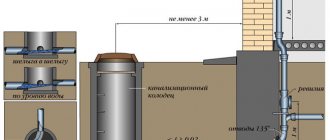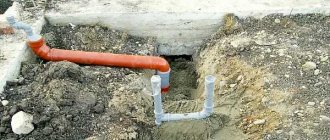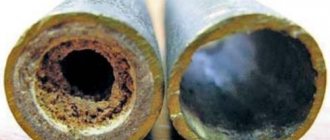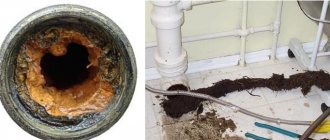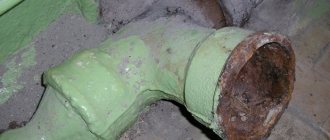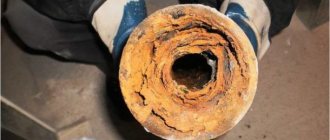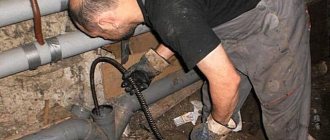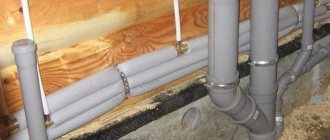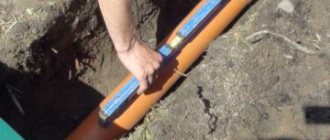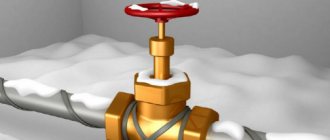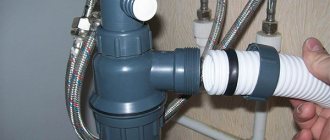How to find out what exactly the problem is?
Identifying a blockage
If a blockage occurs in a Khrushchev apartment or an ordinary high-rise building, it is necessary to determine the exact location of the problem. You should check whether water is draining in all sewer units - in the bath, shower, toilet, in the kitchen. If this does not happen, then you need to call plumbers from the housing office. In such a case, the blockage occurred in the common riser and it is impossible to do without the help of such specialists.
The sewer system in an apartment building or private building may become clogged in other places. This led to the following classification of blockages:
- Operational. The pipes become clogged with grease, to which hair and food debris stick. It is easiest to clear the system of such blockages at home, even without special knowledge and experience.
- Mechanical. It occurs due to the fault of the residents themselves, who throw hygiene products, rags or other things into the toilet. Sometimes a clog appears even from ordinary toilet paper that has not dissolved. Cleaning the sewer in this case takes much more time and effort.
- Technogenic. If sewerage-related accidents occur very often, especially for new apartments or houses, errors in the design of the sewerage system are considered a possible cause. If the drawing for creating communications is made incorrectly (for one building, for an entire avenue or street), it is impossible to fix the problem without the help of professionals.
- Obstruction in the siphon. This device is a kind of filter that prevents the spread of unpleasant odors from the sewer. Over time, a coating of fat forms on its inner surface, to which larger particles adhere. To remove the blockage, you need to unscrew the siphon and rinse it thoroughly.
The main causes of blockages
Blockages in sewer pipes are a fairly common occurrence. There are several reasons for such blockages. The main reason can be called improper operation of this system. The occurrence of a blockage is accompanied by the following consequences:
- the occurrence of an unpleasant odor coming from the drain hole of the sink or other plumbing equipment;
- a decrease in water pressure in the system or its complete disappearance also indicates that the pipe lumen is partially or completely clogged;
- when using a sink or bathtub, you may notice that water is not removed into the drain hole (this also indicates a blockage in the system);
- rising water level in the toilet.
To choose a method for clearing a blockage, you first need to understand the cause of its occurrence. Let's look at what most often causes blood clots to occur in the sewer lines of a private home:
- clogging of the pipe due to a large object that got into it and blocked the lumen;
- overgrowing of pipe walls with solid deposits. Such deposits arise from organic and inorganic human waste;
- the appearance of a fatty film, which is formed due to the entry of fatty particles into the sewer pipe. Grease plugs are considered dangerous for metal pipes.
Helpful information! A greasy film occurs due to improper operation of plumbing equipment into which various food waste containing fat is poured.
- soap stopper. Appears during the operation of a sink in the bathroom of a private house. It is quite difficult to get rid of such a blockage, since the soap that gets into the pipe through the drain mixes with other foreign particles and hardens;
- Hair getting into bathtub and sink drains can also cause clogged pipes. Such a plug can be removed only in two ways: with a chemical cleaner and mechanically;
- errors in the design and installation of sewer communications, which cause stagnation of water and the rapid appearance of various deposits in problem areas. In this case, only re-installation of the system will help;
- if the water has a high hardness index, then the rate of occurrence of salt deposits on the walls of sewer pipes increases. Metal pipes are the most vulnerable in this case.
A sign of blockage in pipes is deterioration in the drainage of plumbing fixtures
Even ordinary toilet paper thrown down the toilet can cause a clog in the sewer pipe.
Use of improvised means
How to clean the drain in a private house or apartment without using expensive chemicals from the store? There are several simple but effective ways.
Uses of baking soda
Soda - without using expensive chemicals from the store
To clean sewer pipes, you must follow these instructions:
- The sink or other appliance needs to be cleaned of accumulated debris.
- Pour a liter of boiling water into the kitchen sink or down the bathroom drain and wait 15 minutes. This will remove any grease that has accumulated in the piping.
- To remove surface blockages, use a plunger.
- A glass of sodium bicarbonate (soda) is poured into the drain hole, and an additional 700 ml of boiling water is poured (you need to check the siphon, it may not be clogged, then it is best to pour it directly into the sewer pipe).
This procedure will be enough to quickly clear a sewer pipe from fresh blockage . These manipulations should be repeated every 3-5 weeks, which will always keep the system in working condition.
The effectiveness of the procedure is achieved due to the fact that baking soda creates an alkaline environment inside the pipeline. This facilitates easy removal of accumulated deposits. Additional positive effects of the procedure include the ability of soda to eliminate unpleasant odors and destroy bacteria.
Sodium bicarbonate and vinegar
To clean your household sewer yourself, you can use this effective folk recipe:
Soda and vinegar - a combination of these substances will remove lime and grease deposits, and also remove blockages
- Half a glass of sodium bicarbonate and the same amount of table vinegar the drain (it is best to first check the blockage in the siphon; if it is missing, it is recommended to pour the product into the sewer drain pipe - watch the video below ).
- When these substances are combined, a chemical reaction will occur that will remove lime and grease deposits on the pipes, as well as clear the blockage.
- Since a lot of foam is formed when sodium bicarbonate and vinegar are combined, it is advisable to add vinegar a little at a time. There is also a way - after pouring the substance, close the sewer pipe drain with a stopper and leave it like that for 2.5 hours.
- Finally, it is recommended to pour a liter of boiling water into the pipes.
- If, after all that has been done, the water goes away slowly or does not go away at all, use a plunger ; the blockage in the pipe is usually eliminated.
Salt and sodium bicarbonate
To break through blockages in pipes, you can use salt and sodium bicarbonate (soda). The indicated ingredients in the amount of 0.5 cups are poured into the drain and poured with boiling water. It is best to do this procedure at night. Nothing must enter the pipeline for 11 hours for cleaning to be effective.
Using baking soda and salt
To prevent the formation of soap and grease plugs in the sewer, you can prepare a special mixture yourself. Combine a glass of sodium bicarbonate (soda) and half a glass of salt 1:2. The resulting mixture is transferred to secure packaging and stored together with household chemicals. It is recommended to pour the prepared powder into the sewer overnight, which will be an excellent prevention of blockages.
Hydrochloric acid
To properly clean your drain, you can use a hydrochloric acid solution. But it should be understood that this substance is very aggressive. This is why it is not recommended for older systems formed from metal pipes. In order not to damage the system elements, it is advisable to use acid with a concentration of 3-10%. Instead of this substance, it is allowed to use unsuitable electrolyte for car batteries. It is suitable for both plastic and cast iron pipes.
Hydrochloric acid solution
To avoid the negative effects of harmful substances on your body, during the process of cleaning the sewer, you need to open all the windows in your visit, ensuring an influx of fresh air from the street. It is also forbidden to climb into acid without personal protective equipment - gloves, masks, goggles.
Caustic soda
A good product that is inexpensive. Caustic soda perfectly corrodes hair, wax, organic matter (meat waste), which causes blockages. The product is used according to the following scheme:
Caustic soda perfectly corrodes hair and wax.
- Mix a small amount of powder with cold water in a bucket.
- A chemical reaction occurs to form foam. The temperature of the mixture increases significantly.
- The resulting liquid is poured through the drain hole.
- It is recommended not to use the plumbing fixture for 2-3 hours to allow the caustic soda to take effect.
We remove blockages using improvised means correctly and consistently
Other improvised means
To unclog your drains, you can use regular instant yeast. They are poured into the drain hole and left for several hours. After completing the procedure, the pipes must be rinsed with plenty of boiling water.
You can also use Coca-Cola to clean your drains. This non-alcoholic drink copes well with limescale and even old deposits on the surfaces of the system. To achieve a positive result, 1-2 liters of Coca-Cola is poured into the drain and left overnight. In the morning, it is advisable to rinse the pipeline with plenty of boiling water. This procedure can be repeated every month, which will keep the system clean and prevent the formation of blockages.
How to clear a clogged sink with baking soda and vinegar
Pour 150 g into the drain hole. baking soda, and pour the same amount of 9% vinegar on top. To prevent the resulting foam from flying out (and a very violent chemical reaction process will begin), close the hole with a stopper.
Cleaning clogs with baking soda and vinegar.
With no less effectiveness, soda can be replaced with the well-known Alka-Seltzer tablets. To cleanse, you will need a couple of tablets, after which you need to pour in a glass of vinegar. After 2 minutes, turn on the hot water at full power. In addition to the main job - removing the plug, the drug will rid the sink of an unpleasant odor.
Cleaning a clogged sink with baking soda and vinegar
This method is very easy to use and the fact is that baking soda, when it reacts with vinegar or boiling water, causes an alkaline chemical reaction inside the tube. And it turns out that the alkali seems to corrode fats, hair and small organic debris - all this, in most cases, consists of overload.
The method of clearing a clogged pipe with soda and boiling water is as follows:
- 1 liter of boiling water is poured into the drain or sink and left for 15 minutes.
- After 15 minutes, you should take a plunger and move up and down to try to "break" the air pressure blockage that this tool creates.
If that doesn't work, pour a glass of baking soda into the hole and fill it with boiling water. In this case, the water should be three times more than baking soda. It is necessary that the soda be as if under load and at the same time “approach” the accumulation as close as possible.
You need to wait 20 minutes and use the plunger again. In theory, if the obstruction is small, it should be removed.
Note! If you see that the situation has improved, but not completely, try adding vinegar instead of boiling water - the alkaline reaction will be much stronger. Only when using vinegar should it not be heated. After this substance is poured in, the drain hole must be closed with a stopper, because the solution will foam and will simply come out without a stopper.
Cleaning pipes with soda, vinegar and chlorine.
This method of removing a plug is used for severe blockages. It is not entirely harmless to people, but is considered one of the most effective options for getting rid of fatty deposits and limescale in pipes.
- Open the windows.
- Remove excess water from the sink.
- Pour 50 grams into the drain hole. baking soda and soda ash.
- After half an hour, pour 150 ml. vinegar and 150 ml. bleach and chlorine and plug the hole with a stopper (rag).
- Leave the room.
- After 30 minutes, flush the drain with plenty of water.
- Don't forget to ventilate the room well.
All in all, it turns out that baking soda and vinegar is the easiest drain cleaning method there is.
Now let's talk about the use of chemicals.
Chemicals
Cleaning drains in a private home can be done using store-bought products. To remove persistent contaminants in the sewer system, experienced professionals recommend using:
- Mole. A domestically produced product containing caustic soda;
- Tiret. Suitable for pipes made of plastic, cast iron and other metals;
- Domestos. The product contains alkali, which helps clean pipes from plaque and blockages.
- Sodasan. Used to clean pipes from limescale.
Causes of blockages in sewer pipes
You can understand that there is an urgent need to clean the sewer pipes in a private home based on two signs: the water goes down the drain too slowly, and a very unpleasant smell comes from the drain hole. There are several reasons why plugs form in pipes:
1. Fat accumulation
This is the main factor. In 70–80% of cases, pipes become clogged with grease that enters the drain from the kitchen, bathroom, washing machines and dishwashers.
The fat plug that forms inside the pipe has a heterogeneous consistency. The part that is closer to the center is quite soft, similar to jelly. But the area in contact with the pipe is much tougher. It is made this way by inclusions of other, harder contaminants such as hair or threads from clothes (from washing machines). Plus, fat accumulations are compacted due to the mineral salts present in the wastewater.
Cleaning fat deposits is more difficult than all other fat deposits. They are very resistant to external influences, and are made even stronger by the air circulating in the sewer pipes.
2. Blockages of mechanical origin
They happen quite rarely, they are only 10–20% of all possible options. A mechanical blockage is essentially some kind of foreign object in the pipe. For example, a large wad of thick paper, cotton swabs, ear cleaning sticks or some kind of mortar washed down the drain, etc.
Cleaning of sewer pipes in a private home may also be necessary due to kitchen waste entering the drain. This refers to accumulations of coffee grounds, leftover food from plates, skins from fruits, vegetables, etc. The cause of mechanical blockage can be small parts from children's toys if they somehow get into the drain.
3. Errors when installing pipes
At some point, polluting plugs will begin to accumulate in the sewer system if the pipeline system was not initially installed according to the rules.
There may be several reasons for this:
- too sharp an angle at the pipe connections;
- insufficient slope;
- pipes of rather narrow diameter were used;
- vent pipes and valves are not installed in the right places;
- the ends at the joints are poorly cleaned - they are rough, covered with burrs and therefore retain dirt.
Even a right angle at the joints can lead to the formation of a plug, or if too many bends are made in a short section of the pipeline.
4. Very old sewer system
Any pipe has a certain service life. Therefore, even if everything was initially installed correctly, but the pipes themselves are very old, blockages will most likely appear frequently.
This applies to a greater extent to cast iron pipes, because they rust from the inside. The surface becomes very heterogeneous, and all kinds of contaminants easily accumulate on it. Their PVC pipes are smooth inside, so fat deposits practically do not linger in them.
Cleaning sewer pipes in a private home will not be a problem if the cause of the blockage is initially known.
Using a plunger
For simple sewer cleaning in a private house or in an apartment in a five-story building, it is recommended to buy a plumbing plunger. This is a simple handy device that gets rid of superficial local blockages. It can be used to break through plugs by creating high pressure in the pipeline. It causes the clog to move - to rise up or fall down.
Clean the drain with a plunger
How to quickly clean a drain using a plunger is described in the following instructions:
- If there is an overflow hole in the plumbing fixture, it is necessary to cover it with a rag or a special lid. This will help prevent low blood pressure.
- The bowl of the plunger must be lubricated with soap or petroleum jelly, which will ensure a tighter fit to the surface.
- The plunger is placed directly above the drain hole and the rubber part is pressed tightly against it. The device is filled with plain water. It should completely cover the rubber part, which will create the necessary pressure.
- The plunger is held vertically and more than 10 movements are made up and down.
- After performing the last operation, the device is sharply pulled out.
- If everything is done correctly, the blockage will be removed immediately. If the plug does not go away, all manipulations are repeated.
Mechanical sewer cleaning
Once the cause and location of the blockage have been found, you need to decide how to clean the pipes.
Pipe clogged with paper
The easiest way to remove a cork from paper is to use a water hammer. A significant increase in fluid pressure on one side will push the ball of paper through the bottleneck.
Important! This will not completely remove the plug, but will only move the clump into the riser. The paper usually becomes limp in the riser and does not cause any more problems. But sometimes it is possible to block the exit to the well or the bed. This nuisance is possible if the drain is clogged with grease, hair or other debris.
Water hammer can be created in several ways:
- With a plunger. Such a device covers the liquid in the area of discharge from the bathtub or sink. When you press the handle sharply, high pressure is created in the pipe;
- You can create a water hammer using a plastic bottle; you need to take a 1.5-2 liter container, screw the cap tightly and cut off the bottom. This device is used like a plunger;
- You can create a water hammer with a simple device made from a stick and a rag, which is folded in several layers. They place it on a surface of water at the point where the toilet flushes, and sharply press it with a stick. Don’t get carried away - too strong impacts can damage ceramic plumbing fixtures.
The last option can only be used when the toilet is clogged. A paper plug that has clogged a pipe cannot be pushed through in this way - when you press the device, the liquid will begin to flow into the bathtub or sink.
Food waste clog
It is better to clean such contamination of sewer pipes with a plumbing cable. Externally, it is an ordinary steel cable of small diameter; on one side of the cable there is a handle with which it can be rotated.
It is necessary to mention several important subtleties of using such a device:
- The cable must be inserted into the pipe under tension. If it weakens, it folds in half and forms a loop;
- It is most convenient to work with a partner; one person stretches the cable and rotates the handle, and the second person pushes it into the pipe;
- The cable should pierce the blockage several times;
- Remaining debris is removed by pouring a lot of water into the pipe.
Cleaning pipes with a vacuum cleaner
This is one of the methods when everyone can clean the pipes themselves, without the help of specialists. The main thing is that the vacuum cleaner has the ability to blow air back. To clean the system you need to:
- A plunger is used, from which the handle is removed.
- A hole is made in the tool that corresponds to the diameter of the vacuum cleaner pipe. Its lower end is fixed, and several clamps are inserted there for reliability.
- The plunger leans against the drain hole and the vacuum cleaner turns on. The air flow created should break down the blockage.
- It is necessary to blow until the water flows normally into the sewer pipes.
Cleaning sewer pipes using a hydrodynamic method
This method of cleaning a sewer pipe is the most radical of all those used. In this case, the blockage is removed with a jet of water under high pressure. To implement this method, you should use special equipment that is available to professionals working in this field.
Using a special cable
Cleaning of sewer pipes in a cottage, country house or apartment can be done using a professional cable. With its help, you can break through the deepest blockages without causing harm to the system. The specified equipment can be used for cleaning both cast iron or steel and plastic pipes. The advantage of the method is that it can be used constantly and without the involvement of specialists in this field who are plumbers.
The cable for clearing blockages is a long steel wire in the form of a spring. There is a handle on one side for ease of use. At the other end of the cable there is a spiral, which serves to secure various additional tools - a scraper, a hook. They are designed specifically to help remove severe blockages.
Pipe cleaning cable
To effectively and easily restore the functioning of the sewer system using a cable, you must adhere to the following instructions:
- It is recommended to remove the siphon, which will make it easier to remove the blockage. The end of the cable is directed to the outlet of the pipe.
- They make rotational movements, trying to push the tool as far as possible. But you don't need to apply a lot of force, which could damage the system.
- When the blockage has been found, it is necessary to increase the intensity of the cable rotation. To do this, you can attach a regular drill to the handle. Gradually the instrument is removed.
- If the operation of the pipeline has resumed, you should turn on the hot water for a few minutes, gradually increasing the pressure.
Using a special cable
When traditional methods don't help
Problem not solved? If first aid does not help, this means that the clog in the sink is old, large and dense. How to clear a blockage in a pipe if traditional recipes do not work? Don’t rush to call a plumber and disassemble the siphon; try using special chemicals (Mole, Tiret, Pothan, etc.) or a plumbing cable.
Method 7. How to clear a clogged pipe using a plumbing cable (and how to replace it at home)
If the kitchen sink is very clogged, you can use a special plumbing cable. This metal device looks like a brush with a long flexible handle (sold in hardware stores). Cleaning water pipes with a cable is best suited for metal structures - it can even partially remove rust. But the method is not suitable for cleaning plastic pipes, since there is a risk of damaging them due to excessive mechanical pressure.
- The cable is placed in the pipe and rotated. Here you can direct the movement both away from you, pushing the blockage into the sewer pipe, and towards you, pulling out the plug.
- When cleaning with a cable, you need to periodically supply water to the sink so that the flow of water washes away the released dirt.
- Run hot water for a few minutes to flush any remaining sediment down the drain.
Clue:
- If there is no cable on the household, then an ordinary metal hanger will come to the rescue, from which you can make a mini cable. Cut it with wire cutters so that the resulting wire has a small hook at the end (see picture below).
Method 8. How to clear a clog in the sink using household chemicals
Special products designed to remove blockages in pipes can be acidic or alkaline. Most often they are:
- Liquid and helium (for example, Sanfor, Tiret Turbo, Deboucher).
- Dry in the form of loose powder or granules (for example, Bagi Pothan, Mole, Chirton “Clean Drains”).
The pipe cleaner is selected depending on the material of the water pipe and the expected type of contamination.
Tips:
- The cheapest, well-known and universal remedy is “Mole”, which is based on acidic compounds and in most cases corrodes blockages of any origin. But for the most advanced cases, we recommend trying the fast-acting remedy Bagi Pothan in the form of granular powder.
- Liquid cleaners for clearing clogs are gentler and easier to use.
- Whatever remedy you choose, first clear the blockage with boiling water for 20 minutes (if the pipes are steel) or with a stream of hot water for 20 minutes (if the pipes are plastic). Then add the cleaning solution exactly following the manufacturer's instructions.
- If children live in the house, then it is better to buy a pipe cleaner for one time in small packages.
- Before you start cleaning your pipes, be sure to wear rubber gloves, otherwise the clog remover will attack not only the stopper, but also your skin.
- If you are planning to clear a clog in your sink using a caustic chemical or vinegar, be sure to open the window.
If none of the above methods work, then it is time to call a plumber. Most likely, the blockage has built up too deep and is packed tightly beyond the reach of most clog removal tools.
Use of professional equipment
If a blockage occurs in the private sector or in an apartment (due to the fault of a neighbor above or below) and cannot be eliminated with available means, it is advisable to resort to the use of special equipment to restore the water flow. You can purchase it yourself at a hardware store.
The pipe cleaning machine is a household pump. This device is powered from the electrical network. Additionally, the machine is equipped with a plastic hose with a diameter of 1 cm, which is covered with thread and inserted into a PVC casing. It has a fitting at one end and a nozzle at the other. A hose is inserted into a pipe that is clogged, and water is supplied under high pressure. Flushing the sewer is an effective method in the fight against traffic jams of varying complexity.
There are several types of similar pipe cleaning equipment:
- drum The production of such equipment is quite complex and labor-intensive, so it is not cheap. But such machines are capable of washing pipes of any diameter;
- manual A good choice for home use, since it is almost impossible not to clog the drain at least once;
- gasoline. The most expensive and efficient equipment. Used in water utilities and other organizations. Can be used for hydrodynamic blowing of external sewerage, which consists of large-diameter pipes.
For home use, you can purchase a machine called Karcher.
Karcher is one of the cleaning methods
It works effectively even in the hands of a non-professional, it cleans simple clogs well, and is quite powerful. To prevent difficulties during its use, it is recommended to watch a video that describes in detail the rules for operating the machine.
A pneumatic method can be used to remove blockages in the sewer system. It involves pumping air into the system under high pressure. In this case, equipment called a compressor is used.
Determining the location of the blockage
To choose the right sewer pipe cleaner, you need to determine the location and nature of the blockage. It can be specific and general. When a point blockage occurs, the flow of water from one consumer is disrupted while all others are operating normally. If there is a general blockage, the liquid does not drain anywhere. This means that the problem is in the sewer riser.
You can find the place where the traffic jam has formed in the following ways:
- Drain the drain and pour water into it. Knowing the volume of liquid poured and the cross-section of the pipe, you can easily calculate the distance to the nearest centimeter.
- Insert the hose from the shower or washing machine into the drain. He will hit an obstacle, indicating the source of the problem.
- Shine a powerful flashlight on the pipes outside or inside them. The cork will be visible visually or darkened against a light background.
Having determined the location and nature of the congestion, you can begin to select means to eliminate it.
How to clean the drain in an apartment
If problems arise with drainage, you must first:
- locate the jam. Most often these are siphons of sinks, sinks, bathtubs, and less often - toilet bowls. If the water does not drain in only one plumbing fixture, but there are no problems in the others, it means that the problem is in the siphon or the pipe coming out of it. If the drainage is difficult or absent in all apartment plumbing, it is necessary to check the pipes, risers and deck chairs. If difficulties arise in several apartments at once, the problem is almost certainly the riser. Such a case requires the intervention of house plumbers; the blockage cannot be eliminated on your own;
- try to clean the drain with soda and vinegar, boiling water, or special means. In this case, it is necessary to take into account the type of pipes (metal or plastic);
- if there are no results, use a plunger (acceptable only for local contamination) and/or a cable (pipe cleaning);
- If the described measures do not work, calling a plumber is required. Otherwise, a “local” problem can very quickly develop into a general one for the entire riser, or even the house as a whole.
Prevention measures
As already mentioned, clog problems occur when sewer systems are used incorrectly. To ensure that problems arise as rarely as possible, you should:
- Stop dumping food waste, toilet paper, personal hygiene products and garbage into sewers. To prevent accidental clogging, it is worth installing removable screens on the drains;
- use detergents and cleaners more often when washing greasy dishes and processing fatty foods;
- at least once a month use alkaline or acidic (according to indicators) products for washing siphons and pipes;
- at least once a year, disassemble siphons under sinks and bathtubs for mechanical cleaning and rinsing, as well as replacing seals and checking the condition of the system as a whole.
Of course, one should not neglect the initial quality of the design and installation of plumbing and sewerage: the better the installation is done, the better the components used, the fewer operational difficulties will arise in the future.
Important: when supplying tap water of poor quality (very hard, clogged with small debris) or frequent water shutdowns, it is recommended to install a coarse filter at the entrance to the apartment/house. This will reduce the risk of mechanical clogging of pipes and the percentage of lime and organic deposits on the internal surfaces of pipes.
What causes a clogged sewer?
In addition to the inevitable contamination of drain pipes with human waste and lime deposits in tap water, there are other factors that influence the extent and frequency of necessary cleaning measures:
- mechanical inclusions. This could be toilet paper, small items (accidentally or intentionally dumped down the drain), or household waste. Removing relatively large things is only possible mechanically; small ones can “come out” of the pipes into the riser on their own when dividing the congestion into separate fragments using cleaning agents;
- chemical deposits. This, oddly enough, includes fat - with frequent washing of dishes without the use of detergents, it is deposited on the walls of the pipes and gradually reduces their clearance. Accordingly, the risk of mechanical congestion increases;
- malfunction of the siphon. This may be due to both mechanical and chemical clogging of the container, and the smaller the diameter of the outlet pipe, the higher the likelihood of accumulation of fat, organic deposits or mechanical debris in the siphon;
- sewer design error. This is the most difficult and unpleasant case, since it cannot be corrected with improvised means. If such a problem occurs in a new house or apartment, you will have to redo the entire system or at least partially replace the bottlenecks. One of the common mistakes is an incorrectly chosen angle of inclination of pipes (beds) or their incorrect installation.
Removing sewer clogs is quite simple if preventative flushing and cleaning measures are carried out regularly. For heavily clogged pipes that have not been cleaned for a long time, the problem may not be solved with home remedies - in this case, you will need the help of a professional plumber, or even replacing part of the sewer system.
